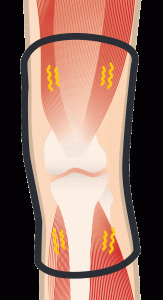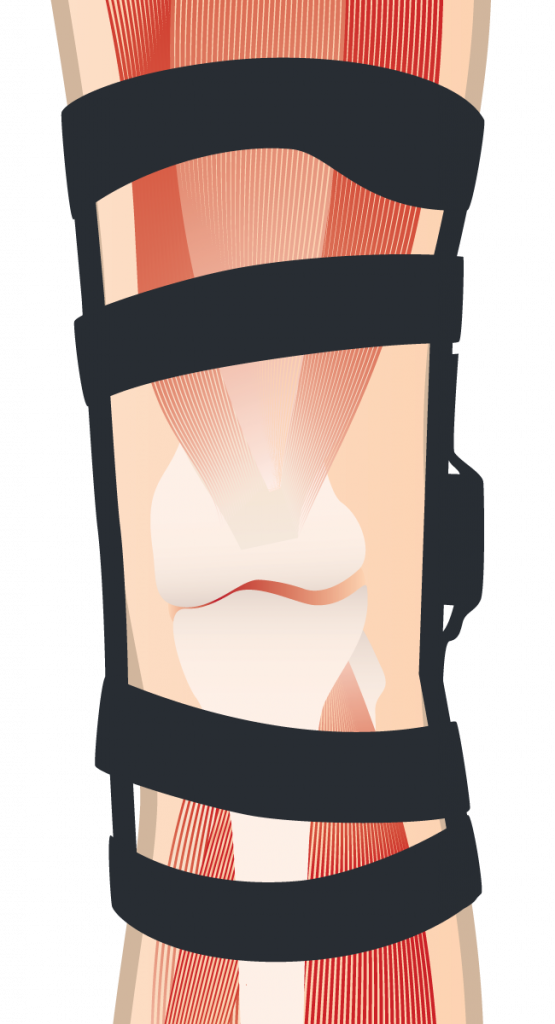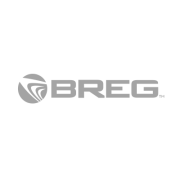Let bracing keep you active
Persistent knee, ankle, or wrist pain can be debilitating. Imagine being able to reduce your pain, promote recovery and get back to doing the things you love. Start your recovery today.
Bracing Categories
How to choose the best knee brace?
Whether it's knee osteoarthritis, a ligament tear, or patellofemoral (kneecap) pain - knee braces can help stabilize your joint, reduce pain and promote recovery. Kintec specializes in custom and off-the-shelf bracing solutions to help treat or accommodate many common knee conditions. Let's review the different types of braces and how they work!
Compression-Based Knee Sleeves
Compression-based knee sleeves are characterized by their lightweight, breathable construction and designed to provide compression to the knee.
These types of knee braces help to improve joint stability and promote a greater awareness of when your knee moves outside of normal limits.
Hinged Knee Braces
Hinged Knee Braces are designed with more rigid components and use a strategic configuration of strapping and hinges to provide enhanced stability or pain relief.
Hinged braces provide a combination of compression, joint awareness and external joint stability. Unlike compression braces, they provide a greater sense of support for side-to-side and forward bending motions.
3 Common Knee Conditions
Knee Osteoarthritis
If you have medial or lateral knee osteoarthritis a compression-style brace can be a good first step for reducing swelling and promoting a greater sense of joint stability. If you're looking for more support and pain relief, Kintec offers unloading hinged braces that reduce joint pressure, relieve pain and reduce the need for surgery.
Meniscus Tear
If you have a meniscus tear, you may feel pain while walking, running, and going up and down stairs. You also may experience clicking sounds and feel like your knee is locking. Hinged unloading braces help treat meniscal tears by providing both an enhanced feeling of instability and unloading the affected area in your knee.
Ligament Tear
Ligament injuries can quickly result in a loss of confidence in your knee stability, especially in the direction of the original injury. To get the best results with bracing, it is important to wear the appropriate level of support for your injury and activity. If the injury is one of your collateral ligaments (MCL or LCL) often a compression brace will provide all the support you need. If the injury is to one of the inside cruciate ligaments, such as the ACL or PCL, then a rigid, hinged brace is recommended to provide the necessary external support restricting forward-back motion of the tibia.
How to choose the best ankle brace
Ankle injuries require a mix of recovery treatments, depending on severity. Our team will recommend the appropriate solution based on your injury and needs, and educate you on the proper treatment plan to ensure success. We have custom and off-the-shelf bracing solutions including:
- Ankle stabilizers
- Air-stirrups
- Custom gauntlets
- Walker boots
- Foot drop bands
- Compression

Relief for heel pain, bunions, and more
Plantar Fasciitis is the most common cause of pain on the bottom of the heel. At first, it may seem like a minor problem, but it can have cumulative effects on your quality of life and overall health over time. Each year we help thousands of people with this and other foot-related issues so they can live more active lives. It’s why we do what we do!
- Plantar Fasciitis night splints
- Heel cups
- Toe separators
- Hammer toe cushions
- Insoles
- Bunion splints
- And of course… Orthotics!

One of the most disruptive upper body injuries
Shoulder injuries are notorious for their slow recovery time. Our goal is to find you a product that will help speed up your recovery process while minimizing pain. We have many solutions that allow you to function comfortably day-to-day while recovering from surgery or rehabbing a shoulder injury.
- Slings
- Stabilizers
- NoDisco strap

How to choose the best elbow brace
The most common injury that we see at Kintec in the elbow area is epicondylitis, otherwise known as “tennis elbow”. You certainly don’t need to be a tennis player to experience this painful condition as most cases of ‘tennis elbow’ occur in people working in the trades or who have to maintain a closed-grip hand position for prolonged periods of time. Epicondylitis causes pain where the tendons of your forearm muscles attach to the bone on the outside of your elbow. This pain may also spread into your forearm, or up into the biceps area.
Bracing solutions for elbow injuries:
There are a variety of braces available for the elbow. Because these joints are complex, it is important to ensure we are targeting the correct area for the brace to be effective. Let’s review some of the most common bracing options for the elbow below.
One of the most common treatments for epicondylitis is a counterforce brace, such as the Band-it Forearm Strap, the MedSpec Epigel Strap, or the Bauerfeind Epitrain Elbow Sleeve.
How do they help?
These braces are designed to work by compressing the upper forearm and absorbing the forces which are transmitted through the soft tissues to the point of pain on the outside of the elbow. They also help redistribute the forces which are applied to the tendon attachment allowing the injured area time to recover. These braces are simple to put on and can be adjusted for a snug fit.
If you have recently had surgery on your elbow or biceps tendon, you may be prescribed a Donjoy X-Act ROM Elbow Brace to wear post-operatively. This brace is typically only used when the joint needs to be immobilized.

How to choose the best wrist brace
The wrist is a complex area with many tiny joints. The most common injury we see at Kintec is carpal tunnel syndrome that is caused by pressure on the median nerve. The carpal tunnel is a narrow passageway surrounded by bones and ligaments on the palm side of your hand. When the median nerve is compressed from overuse of the surrounding tissue, the result can be numbness, tingling, pain or weakness in the hand and arm.
Bracing solutions for wrist injuries:
Common braces to support the wrist in the case of carpal tunnel syndrome, wrist sprains, or post-fracture-cast recovery are the Kintec Actifit Wrist Brace and the MedSpec Tripod Wrist Brace. Both are lightweight and comfortable options to wear during the day or at night, with a simple Velcro closure, and can be hand washed.
For more severe sprains, fractures, or cases of carpal tunnel that are recurring and refuse to get better, the Exos custom heat molded wrist, thumb, and hand braces can provide more immobilization and support. These products are only available at certain Kintec locations, so please call us if this is something you are interested in.
How do they help?
These wrist braces all work from the same premise - restricting how much your wrist can bend during activities or sleep to allow the carpal tunnel, and the compressed tissues within its space, to rest and reduce inflammation.

Book an Appointment
Our One2One program provides the highest level of safety and personalized service for your brace fitting.










